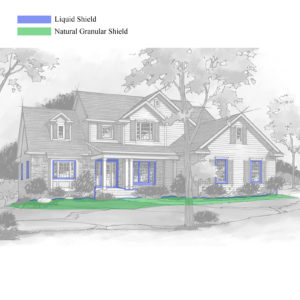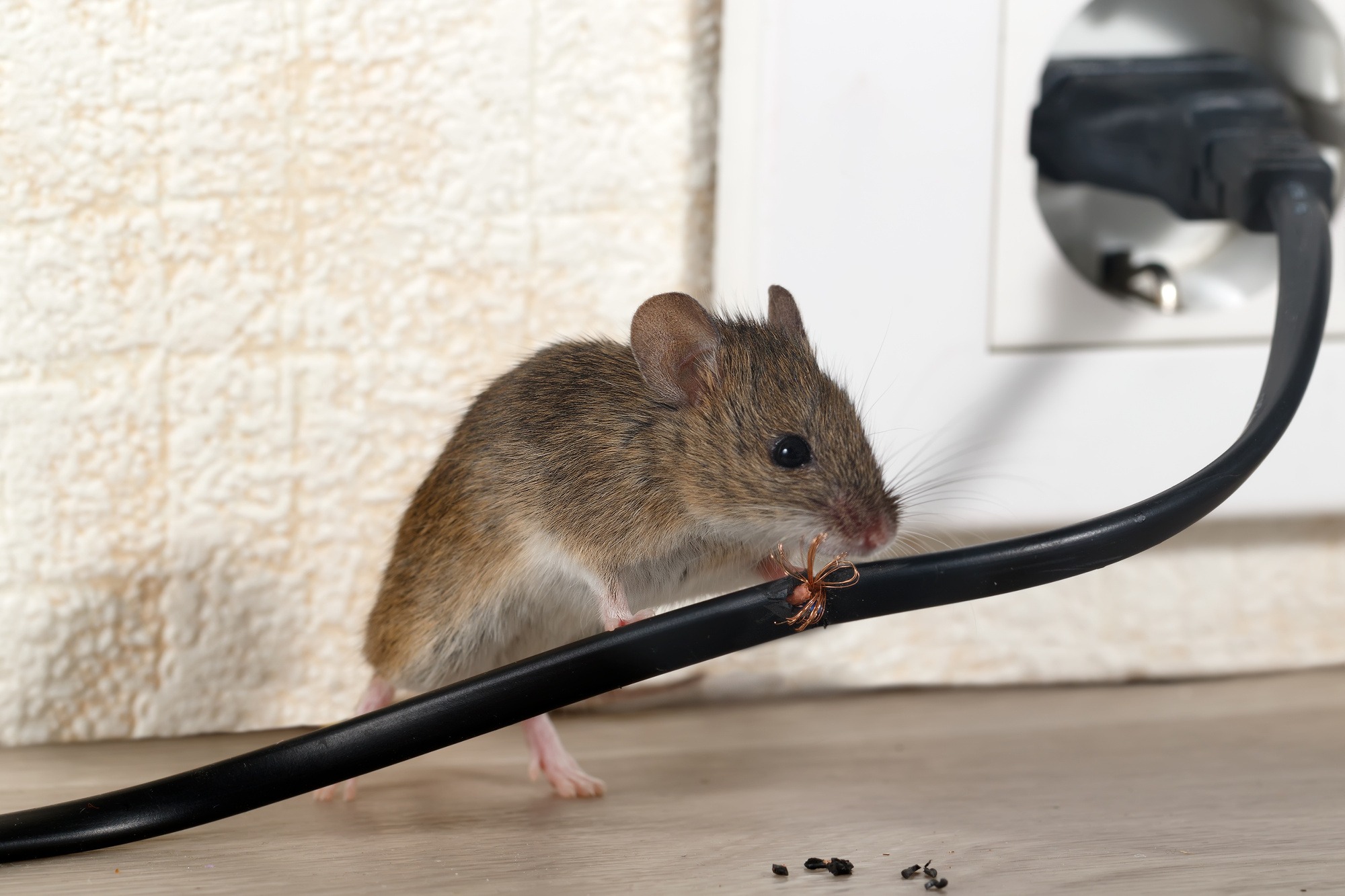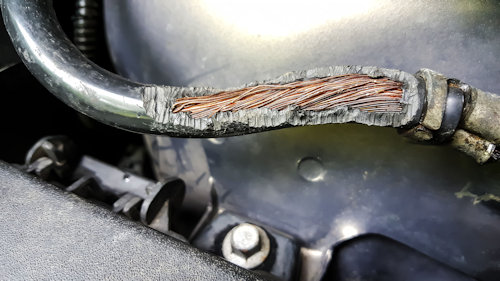Eco-Smart Rodent Control – Initial Visit
$580.00 Original price was: $580.00.$250.00Current price is: $250.00.
Keep Mice on The Outside.
Understanding The Role of White-Footed Mice in Lyme Disease Transmission and the Impact of Rodent Control on Tick Populations. Click product description to learn more.
Our rodent control program focuses on keeping rodents out of the home with the use of exterior bait stations along with interior treatments when necessary. We help to identify and provide recommendations to control food sources, habitat and access points.
Protect Your Home and Family – Keep Mice Away
White-footed mice play a big role in spreading Lyme disease. Stopping mice from coming inside can help lower tick populations around your home.
Our rodent control program is designed to keep your home mouse-free. We use outdoor bait stations to create a protective barrier and, if needed, treat inside your home to remove any mice that get in. Our team will also help you find and fix things like food, shelter, or entry points that might attract mice, giving you tips to keep them out for good.
Keep your home safe and your family healthy – click to learn more about our rodent control program today!
Understanding The Role of White-Footed Mice in Lyme Disease Transmission and the Impact of Rodent Control on Tick Populations
Introduction
Lyme disease is a growing health concern, particularly in our area where black-legged ticks (Ixodes scapularis) are prevalent. The disease is caused by the bacterium Borrelia burgdorferi, which is primarily transmitted to humans and other animals through tick bites. Ticks acquire B. burgdorferi by feeding on infected white-footed mice (Peromyscus leucopus), which serve reservoirs for the bacteria.
Understanding the relationship between these rodents and tick populations is essential to formulating effective strategies for Lyme disease prevention. Here we’ll explore the transmission dynamics between white-footed mice and black-legged ticks and discuss how managing rodent populations can reduce the risk of Lyme disease.
How Black-Legged Tick Nymphs Acquire Borrelia Burgdorferi
Black-legged ticks are born free of B. burgdorferi and must acquire the bacteria through feeding. Nymphal ticks, which are the primary carriers of Lyme disease due to their size and feeding habits, often acquire the bacteria when they feed on small mammals such as white-footed mice. The white-footed mouse is one of the most competent reservoirs for B. burgdorferi, meaning it is highly effective at maintaining and spreading the bacteria. When a nymphal tick feeds on an infected mouse, it ingests the bacteria, which then persist in the tick’s midgut and can be transmitted during its next blood meal, potentially to humans and other animals.
The Importance of White-Footed Mice in the Lyme Disease Cycle
White-footed mice play a crucial role in the Lyme disease cycle because they are highly abundant in tick-prone areas and maintain a high prevalence of B. burgdorferi. Unlike other animals, mice have prolonged interactions with ticks due to their small home ranges and high reproductive rates, which keep them available as hosts year-round. Additionally, mice are poor groomers, meaning that ticks are less likely to be removed before completing a blood meal. This close relationship between mice and ticks makes white-footed mice essential for maintaining B. burgdorferi in the environment.
The Impact of Rodent Control on Tick Populations
By reducing white-footed mouse populations, it is possible to disrupt the Lyme disease transmission cycle. During winter, white-footed mice seek shelter in warmer areas such as residential yards, increasing the likelihood that ticks will find suitable hosts close to human dwellings. Removing or controlling rodent populations around the home during the winter can help reduce the number of infected nymphal ticks in the following spring. Without a suitable host to feed on, ticks are less likely to survive, effectively reducing the risk of Lyme disease exposure in human environments.
Best Practices for Rodent Control to Reduce Tick Populations
To minimize rodent populations, homeowners can take several practical steps:
- Seal Entry Points: Close off gaps in foundations, doors, and windows to prevent rodents from entering homes and garages.
- Eliminate Food Sources: Store food in rodent-proof containers and avoid leaving pet food or birdseed outside.
- Clean Up Yard Debris: Remove leaf litter, wood piles, and other debris where rodents may seek shelter.
- Population Control: subscribe to Planet Friendly Pest Control’s exterior rodent control program.
By implementing these control measures, homeowners can decrease the likelihood that ticks will be carried into their yards by white-footed mice and reduce the potential for Lyme disease transmission in the spring.
FAQs
Q: Why is the white-footed mouse so important in Lyme disease transmission?
A: White-footed mice are efficient carriers of B. burgdorferi, which causes Lyme disease. Their abundance, small home ranges, and high reproductive rates make them a consistent host for black-legged ticks, allowing ticks to effectively acquire and spread the bacteria.
Q: How can rodent control reduce the risk of Lyme disease?
A: Reducing the white-footed mouse population limits the number of infected nymphal ticks in residential areas. Without mice to feed on, fewer ticks survive, and thus the risk of Lyme disease transmission decreases.
Q: What is the most effective way to prevent rodent infestations?
A: Sealing entry points, eliminating food sources, cleaning up yard debris combined with a professional population control plan are essential strategies for preventing rodent infestations around the home.
Q: Are there specific times of the year when rodent control is most effective?
A: Winter is an ideal time for rodent control since white-footed mice seek shelter in warmer areas, including human dwellings. Controlling rodents during this season helps reduce tick populations in the spring.
VIDEO: How to get rid of mice! How do exterminators get rid of mice? Are Mice Dangerous?
This service is the installation and set up of the exterior bait stations. After the initial installation there is a monthly fee of $70 to inspect and rebait the stations during seasons of rodent activity. The primary rodent season is November - March. For your convenience, your future monthly treatments will scheduled automatically by our office and you will be billed via email after each future treatment. You can then pay online or mail us a check.
There is also a additional fee for interior trapping. The interior trapping fee starts at $125. Please refer to our rodent control service page on our website or give us a call with questions about these fees.
Once you purchase this service our office will contact you within the next business day to let you know of your service date. Because this bait station installation service is on the exterior of the home no one needs to be there unless you would like to be. If you need interior service, have any questions, or need immediate service please give us a call 800-990-0335
NOTE: Any discounts from coupons are a one-time discount. The discount shall only be applied to the service(s) in this shopping cart and NOT toward any future or recurring services.
You may also like…
-
Sale!

Eco-Smart NO SPRAY Mosquito Control – Initial Visit
$620.00Original price was: $620.00.$300.00Current price is: $300.00. -

Eco-Smart Perimeter Pest Control – Initial Visit
$135.00 -
Sale!

Eco-Smart Tick Control – Exterior Perimeter and Recreational Spaces – Initial Visit
$210.00Original price was: $210.00.$105.00Current price is: $105.00.
Related products
-
Sale!

Eco-Smart Perimeter Ant, Spider & Crawling Insect Protection – Initial Visit
$265.75Original price was: $265.75.$140.00Current price is: $140.00. -
Sale!

Initial Site Check
$125.00Original price was: $125.00.$95.00Current price is: $95.00. -
Sale!

Rodent Control Special – Initial Visit
$325.00Original price was: $325.00.$199.00Current price is: $199.00.
NEED HELP?
If you live in Southern Maryland, or Northern Virginia
FIND YOUR SOLUTION HERE
People, Pet & Pollinator Safe! Pest control for people who care.










